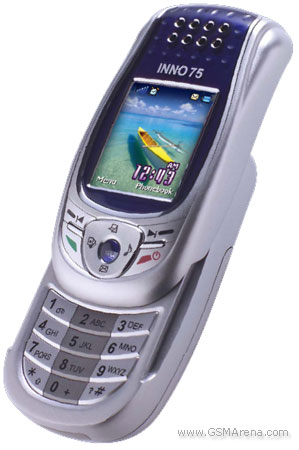Innostream INNO 75 Comprehensive Review of Specs Prices Pros & Cons

Overview of Innostream INNO 75
The Innostream INNO 75 is a feature phone that was announced and released in the second quarter of 2004. Despite being discontinued, it remains an interesting piece of technology from the early 2000s when feature phones were at the height of their popularity. The INNO 75 is known for its compact design and straightforward functionality, making it a desirable option for those seeking simplicity in a mobile device.
Design and Build
The INNO 75 sports a compact and lightweight design, measuring 82.5 x 44 x 23 mm and weighing only 80 grams. This made it ideal for users who preferred carrying a phone unobtrusively in their pocket or bag. The phone features a Mini-SIM slot, making it compatible with various GSM networks. In terms of aesthetics, it embraces the classic early 2000s design with a simple, functional layout.
Display
The phone is equipped with a TFT display that supports 65,000 colors, a standard for feature phones at the time. Although the exact size of the screen isn't specified, it offers a resolution of 128 x 128 pixels with a 1:1 ratio. This provides clear enough visuals for basic phone functions such as calling and messaging.
Camera Specifications
The INNO 75 comes with a single VGA camera of 0.3 MP, which was quite standard for phones of its era. This camera allows users to capture basic photos and videos, providing them with the convenience of a digital camera in a portable device. Though not comparable to modern smartphone cameras, it served its purpose for casual photography needs.
Battery and Power
Powering the INNO 75 is a removable Li-Ion battery with a capacity of 650 mAh. Though this may seem small by today's standards, it was typically sufficient for feature phones that were mainly used for voice calls and text messaging. The removable nature of the battery also provided users with the flexibility to replace it easily, extending the phone's usable life.
Connectivity and Network
The Innostream INNO 75 supports GSM technology, operating on 2G bands including GSM 900, 1800, and 1900. It comes with GPRS class 10 for basic mobile internet services but does not support EDGE, which limited its data connectivity speed. Additional connectivity features include an infrared port and FM radio, catering to users’ entertainment and data transfer needs. However, it lacks Bluetooth and WLAN, which are standard in modern mobile devices.
Memory and Storage
The device includes a miniSD slot for expandable storage, though the internal RAM and storage capacities are unspecified. This expansion capability was beneficial for users who needed to store more contacts in the phonebook and save multimedia files. The phone supports call record logging for 20 received, dialed, and missed calls, reflecting its focus on basic telecommunication functions.
Audio and Multimedia
The INNO 75 lacks a loudspeaker and a 3.5mm audio jack, necessitating the use of earbuds with a proprietary connector or mono audio output through its speaker. It supports vibration alerts and downloadable polyphonic ringtones, which were popular at the time for personalizing phone notifications.
Software and Interface
Operating as a feature phone, the INNO 75 offers a basic and easy-to-use interface. It supports messaging options like SMS and MMS, enabling users to send text and multimedia messages. The WAP 2.0/xHTML browser provides access to simplified mobile web services. Furthermore, it comes with a few games, with the possibility to download more, and supports Java MIDP 2.0 applications, which extend its utility for entertainment and productivity.
Conclusion
The Innostream INNO 75 represents a snapshot of early 2000s mobile technology, embodying the era's emphasis on simplicity, reliability, and essential functionality. While it may not offer the advanced features found in today's smartphones, its compact build and essential features provided an effective communication tool for its time. For those interested in mobile phone history or in search of a no-frills device, the INNO 75 remains a noteworthy option worth exploring.
Key Features of Innostream INNO 75
- Supports GSM network technology with 2G bands (GSM 900 / 1800 / 1900).
- Lightweight design, weighing only 80 g (2.82 oz).
- Compact dimensions: 82.5 x 44 x 23 mm (3.25 x 1.73 x 0.91 in).
- TFT display with 65K colors and a resolution of 128 x 128 pixels.
- Expandable storage via miniSD card slot.
- VGA main camera with video recording capability.
- Equipped with FM radio for entertainment.
- Infrared port for data transfer.
- Downloadable polyphonic ringtones.
- Multimedia messaging services (SMS, MMS) support.
- WAP 2.0/xHTML browser for basic internet browsing.
- Java support (MIDP 2.0) for application downloads and usage.
- Removable Li-Ion battery.
Drawbacks of Innostream INNO 75
- Lack of EDGE technology for faster internet.
- No front-facing (selfie) camera available.
- No loudspeaker, which limits audio playback options.
- Absence of a 3.5mm headphone jack.
- Does not support Bluetooth connectivity.
- No Wi-Fi capability for internet access.
- Lacks GPS for location services.
- Limited camera resolution with only a VGA camera.
- Discontinued production, making it difficult to purchase or service.


View Also
More Phones
All Rights Reserved +13672 Phones © Mobilawy 2025
























